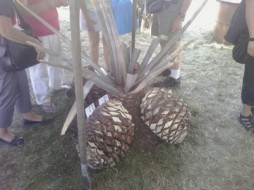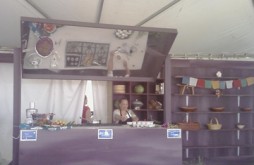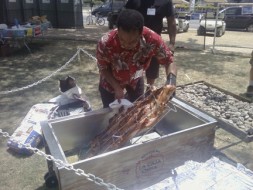Live from the Mall: It’s the Folklife Festival
The 44th annual Smithsonian Folklife Festival features three special programs this year: Asian Pacific Americans: Local Lives, Global Ties; Mexico; and Smithsonian Inside Out. Will McCurry, an intern in the Office of Public Affairs, offers his impressions of the people, performances and presentations at the Festival.
July 1
One of the great things about the Folklife Festival is that you get a chance to learn something new every day. Today, I shared that chance with my friend, Nicole Bleecker, her 10-year-old brother David, and her mom. Nicole had never been to the festival before so I took it upon myself to show her the best sights and features of the festival.
We started by walking through “Asian Pacific Americans: Local Lives, Global Ties” where we watched families learn how to tie a turban and practice calligraphy drawings of their names. This particular section of the festival focused on the cultural customs and practices associated with the Sikh people, whose religion and culture originated in the Punjab region of South Asia. Sikh men honor their religion by wearing turbans to cover their heads as a sign of humility and respect.
We chose the Indique Heights concession stand for lunch and chose from among several different delicious Indian recipes ranging from buttered chicken tikka to a puffed rice snack, bhelpuri.
Our next stop was the “Smithsonian Inside Out” and the Mysteries of the Universe tent. David was instantly enthralled by a dmonstration that showed how to observe the sun using a specially designed sun viewer. A sheet of light metal covered a tiny view-hole from which visitors could safely view the sun without damaging their eyes. David used a small wooden device with a mirror built into it to show us a full image of the sun reflected on the wood. The detail was defined enough for us to even see the small black dots of actual sunspots on the sun. We learned that sunspots are areas of gas and plasma on the sun that are considerably cooler than the surrounding area. One sunspot we observed was twice as large as Earth.
Watch a video about the Smithsonian Inside-Out program featured at the 2010 Folklife Festival.)
June 28
One of the best things about cooking is that, no matter what culture you claim as your own, everyone has an appreciation for food. I think that food can connect people of vastly different cultures more than anything else. Today, in the Asian Pacific American section of the Folklife Festival, chef Darlene Butts demonstrated how to prepare a traditional Hawaiian luau feast, complete with whole roasted pig and other delicious traditional Hawaiian dishes.
In Hawaii, according to Butts, the culture is such that younger members of society address their elders as either “Auntie” or “Uncle” because of the strong communal sense that everyone in the community is a member of your family, or ohana. Butts started her culinary career at the tender young age of eight when she started to wash rice for her “uncle”—a neighbor who owned a catering business and who would throw giant festive parties on the weekends.
Butts attributes her love of food and cooking to her uncle who helped his neighbors by looking after the neighborhood children and putting them to work with him in the kitchen. Today Butts continues this tradition of passing her culinary knowledge on to the next generation. Her 10-year-old granddaughter, Leila, was her assistant throughout her demonstration. When Darlene Butts asked the audience who inspired them to start cooking, little Leila immediately piped in “Grandma!”
The best thing about Hawaiian luau cooking is that “Hawaiian food is simple,” Butts said. Hawaiian food doesn’t rely on a lot of seasoning to spice up dishes; salt is the seasoning in luau cooking. Butts prepared a delicious assortment of food includeg, Chicken long rice with carrots, celery and shitake mushrooms; lomi salmon wrapped in banana leaves; a whole roasted pig and coconut pudding for dessert.
June 25
Today I had the opportunity to accompany Development Officer Kevin Blackerby on a Verbal Description and Tactile Tour. Though much of the Folkife Festival is geared toward visual displays and visual learning, the Smithsonian makes a particular effort to ensure the Festival is accessible to persons with visual impairment. The tour allowed a group of legally blind visitors to have special access in order to touch and smell displays that normally are off limits to the average visitor.
The tour started off in the Mexico area where the group talked to candy makers who specialize in making caramelized fruits and vegetables—anything from bananas and apricots to carrots and onions. The whole caramelization process takes about four days and the tour group was allowed to touch the various fruits and vegetablesto learn how they are transformed.
We then moved on to the tequila and mescal display tents where the blind visitors were able to feel the tough, sharp agave plants that are used to make tequila and mescal. As the tequila maker explained how tequila is made, the tour group sniffed various bottles of sweet-smelling tequila that had already been prepared. Without the use of their sense of sight, these visitors were able to rely on other senses to achieve a better appreciation for the process of distilling tequila.

Visually impaired visitors examine an agave plant, from which tequila is distilled. (Photo by Will McCurry)
One visitor, Sheridan Gates, explained that she and others with limited sight, have learned to appreciate things through different senses. “Gratitude comes through having something taken away,” she said. “You learn to appreciate what you have left.”
June 24
As I was wandering through the Smithsonian’s Folklife Festival on the National Mall in downtown Washington, D.C., in weather that could only be described as scorching, blistering and downright oppressive, I suddenly found myself in an entirely different world. Somewhere between the Castle and the Washington Monument, I had crossed the border into Mexico. The aroma of tortillas, rice, beans and grilled meats wafted through the air and all around me I could hear men singing in Spanish while women danced in exotically beautiful hand-crafted dresses. Mexico is one of the three themes at this year’s Folklife Festival and I decided to spend a few minutes listening to a trio perform traditional Latin American music.
Suddenly, an elderly couple (well, elderly to me—I’m 19) was inspired by the music to get up and dance. Their vigorous dance—a combination of a waltz and the Charleston—was not remotely traditional, but it seemed to suit the music perfectly. As the emcee pointed out, “Music and dance don’t have borders. No matter what our cultural differences, we can all communicate through dance and song.”
In a nearby tent, the Vicente family was giving a presentation on traditional weaving. The Vincentes, from southern Mexico, have been weavers for five generations—more than 100 years. Joel Vincente, his wife and their daughter, demonstrated how natural ingredients, anything from rocks and plants to insects, are used to create dyes for the wool. Since no chemicals are used to create artificial colors, the Vincentes look to the natural world to inspire their elaborate and beautiful works.
As the Festival continues, I’ll be investigating more of the programs and meeting some of the fascinating people who are participating.
Posted: 28 June 2010
- Categories:






